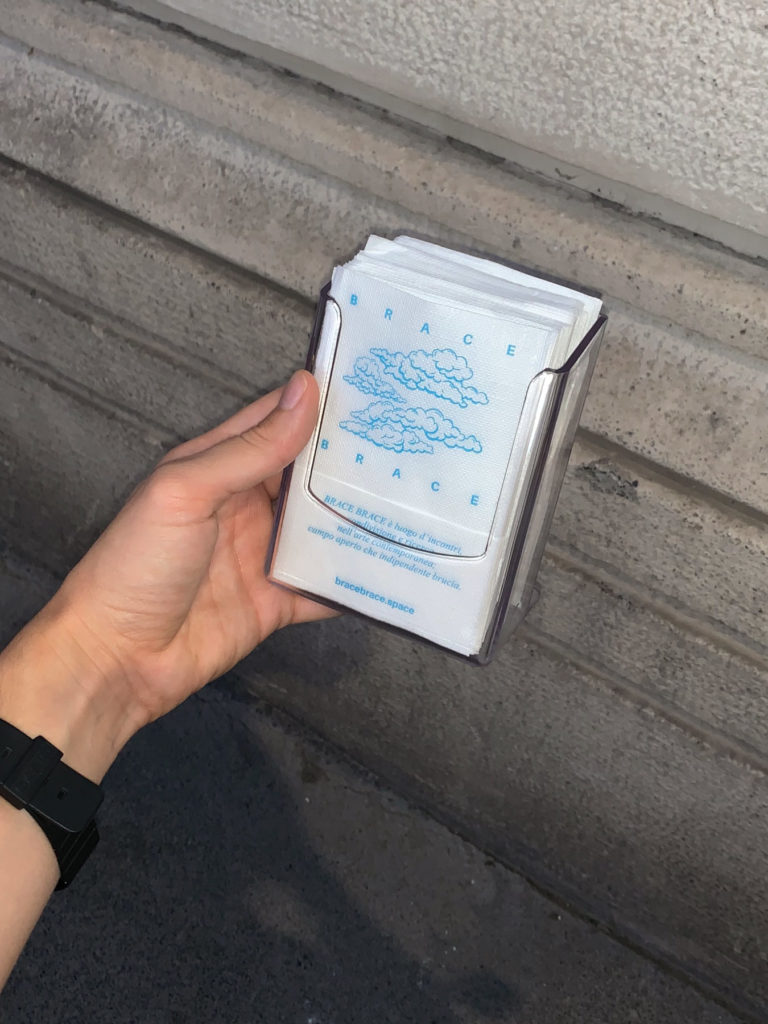BRACE BRACE: the artist-run space that is burning Milan


One exhibition after another, the guys of BRACE BRACE have come to create a real cultural proposal, moving between research and planning autonomy.
“BRACE BRACE is a meeting point, a place for sharing and research in contemporary art; open field which burns independently”. It is the presentation of the independent cultural space and artist’s studio located in Via Termopili 36 in Milan and founded by visual artists Francesca Finotti, Cecilia Mentasti and Francesco Paleari, photographer and professor at the Master of Photography of IUAV University in Venice.
Coming to life from three personalities with different backgrounds, BRACE BRACE is at the same time a curatorial project and an exhibition space, with an art direction strongly marked by interdisciplinarity.
It is also accompanied by a varied scientific Committee, which includes Simone Salvatore Melis (identity and graphics), Elisa Di Nofa (communication and social strategy) and Flavia Albu (curatorial support). Since the birth of the space, five exhibitions have been held at BRACE BRACE, while the founders have developed over time an unprecedented planning autonomy within the context of the independent spaces and outside the gallery system.
Founded in 2019, BRACE BRACE was initially conceived as an artist’s studio.”It was born as an artist’s studio, but we realized that it was a place that lent itself very much to the organization of exhibitions and events”, says Mentasti. “We are very open to experimentation even with very precise internal rules, but the birth was spontaneous, and this was also a nice thing because it was actually a necessity that we had and that gradually has been articulated in different ways”.
Therefore, the transition from an artist’s studio to an exhibition space came by itself, in a context of work and research. To notice how very strong was the influence of the physical place. BRACE BRACE was born in a former studio on the ground floor of a classic Milanese palazzo, in Via Termopili, really close to the Pasteur metro station and near the gentrified Piazza Morbegno. “It has been a serendipity approach”, says Paleari; “We had the opportunity to have this space, so we took the opportunities and the potential and we wanted to make the most of them. It was a game between several subjects, and one of these was space; space that suggested a certain use and that we have exploited, at the beginning spontaneously and then in an increasingly programmatic way, aware of which were the limits and what the potentials.” One of the strengths of Via Termopili’s space is in fact the possibility to modify the physical composition of the interiors, according to the needs of the project and the artist. Composed of three rooms, two of which with windows and facing onto the street, it has been used in different ways and combinations by each artist who has exhibited there. “There is a room that serves as a laboratory and others that we use more as a study”. Francesca tells me: “The only stake we set ourselves at the beginning was to say to the artists, ‘think about something you haven’t had the chance to do yet’, perhaps because working with galleries or because other types of more institutional spaces often do not give the same freedom, or for lack of technical help, you couldn’t tear down a wall. You can do unthinkable things”.


Last October it was held the exhibition of Jacopo Rinaldi iio sono un disgraziato e il mio destino è di morir in prigione strangolato (I am a wretch and my destiny is to die strangled in prison) which had his focus on the study of the photographic production of the anarchist and italian historical character Gaetano Bresci. The exhibition by Jacopo Rinaldi is a good example of the design freedom that accompanies BRACE BRACE curatorial work. Starting from a historical analysis, Jacopo Rinaldi has built a direct dialogue with the exhibition space, setting the book The Anarchists by Cesare Lombroso in one of the walls. Mentasti says: “Talking about cultural proposals, in our context the job is still to make a selection of projects that we think are valid, it is an ethical role within the system”. And she goes on: “Being independent gives us great freedom to support artists without necessarily having to think about the economic aspect of a project. For example, we had not too much trouble getting a first edition of Cesare Lombroso’s The Anarchists into a wall”.

The exhibitions held at BRACE BRACE cover a range of different fields and disciplines, with the strong influence of an approach related to image and visual culture. This interdisciplinary approach of BRACE BRACE is son of its founders’ education and training. Mentasti explains: “Our background is very important, which is also the reason why we were able to do a work of experimentation that seems very unitary from the outside, precisely because we have many different skills, and when they work together they need some level of precision. Very different areas, but perfectly relatable to each other. Francesca and I, for example, come from the Academy (in Brera), while Francesco is a photographer”.
Together with the interdisciplinarity, the planning autonomy of BRACE BRACE is expressed by the accompaniment of specific artifacts and objects linked to each exhibition. Booklets, posters, and unpublished publications support every project that comes to life in Via Termopili. “We do all of this always trying not to brand ourselves too much”, says Paleari; “We try to remain mimetic, we do not want to show a superstructural identity within the event. Every artifact that is produced gets into the needs of the exhibition, changing from time to time by type and support”.
The exhibition held at Marsèll Paradise in Milan, A is A is A, sided by an installation of From outer space, was created by graphic designer Marcello Jacopo Biffi and curated by BRACE BRACE. Starting from a typographic research on the creation of an alphabet, he comes to a reflection on the construction of the letter as a sign to which a meaning is associated. “We asked ourselves: what could enrich and give a further opening to the discussion?”, says Finotti. The exhibition has been accompanied by a series of critical texts, a ‘projection, and a digital transposition of the project. On the occasion of the finissage of A is A is A, named A conversation about the loss of control, moving from Marsèll Paradise to Via Termopili, BRACE BRACE organizes a talk and presents an unpublished publication by Marcello Jacopo Biffi that collects the work of the exhibition A is A is A. Paleari explains: “Our operation with Marcello’s exhibition was aimed to contaminate his work, the project was already structured, and when he met us he found a new outlet”. This is the kind of thing we like to offer”. He goes on: “It is a question of thinking that any project that goes on display can receive a different reading depending on the person who uses it; since we turn to a very diverse audience, it is our task to open up the projects and reveal the connotations that are already inherent but perhaps not so obvious”.


The diverse audience is one of the first things you notice when taking part in an event by BRACE BRACE. Moving between different sectors, the climate that is created during the opening nights of Via Termopili is a mixture of people from various environments, from the Academy student to the old lady who lives upstairs. Paleari says: “Milan is a city where many things happen, many different events but each one conceived and enjoyed by people who come most of the time from the same circle; it is really difficult to find among the different realities a real mix of the public”. In this sense their project is different from any other: “We believe that this is a great value relating to what we do. This eclecticism enriches the experience: we like thinking about BRACE BRACE as an hub activator of an exchange of opinions and skills, also and above all, for the audience that attends it”.


The last exhibition that was supposed to be held at BRACE BRACE, A political Statement, made on the occasion of SPRINT 2020, had to be moved online, with a new formulation designed ad hoc for the BRACE BRACE website. The exhibition took shape starting from a dialogue between the video works Rondini by Ginevra Dolcemare and This political statement is a suggestion on how political statements should now be by Guidor. The curatorial intervention of BRACE BRACE consisted in the creation of two bibliographies related to the works, written in collaboration with the artists. In doing so, the text that accompanied the exhibition is unfinished, which leaves to the public the opportunity to complete the experience on his own. “While dealing with the curatorial side, as none of us has a curatorial education, it is not tied to a knowledge-superstructure that tells you how you should do an exhibition. In fact, as artists, we would like to do the exhibitions exactly as they should not be done, therefore we tend to have an intimate relationship with the work of other people we work with, seeing it almost as if it were ours. A political Statement had this characteristic, to say ‘as curators, we give you books to read to write a hypothetical text, but surely we do not write it ourselves’”.
Speaking about their projects for the year that has just begun, the members of BRACE BRACE have clear ideas. Finotti says: “It is very likely that our project will expand and become increasingly dislocated at a spatial level”. And he goes on: “We are very open on the ways that the project can take in the future, we are growing, we are still learning and BRACE BRACE is becoming an adult”. Paleari adds: “Surely we are very eager to go back to making projects physically. It was a great challenge to find ourselves forced to move programming online, but we really want to reopen the doors in the truest sense of the word. In the future, we hope to expand even more our type of cultural proposal”.
